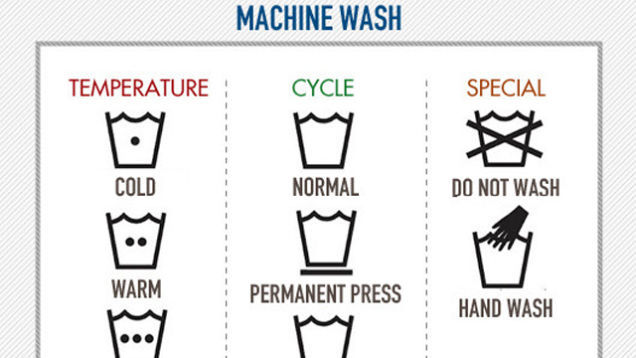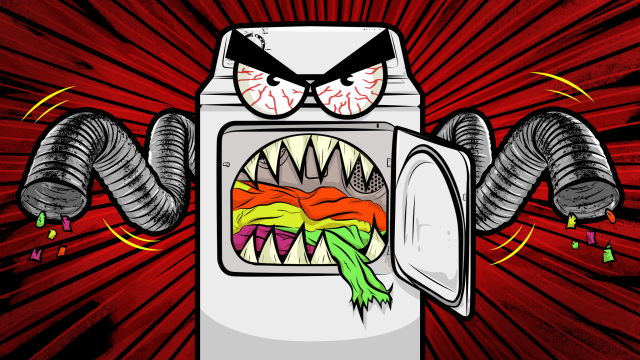Theoretically, it’s better to spend more on quality, but that’s only true if the quality item lasts. I used to have a bad habit of tossing my clothes into the dryer without giving it much thought. If you buy quality, this is an expensive mistake. Here’s how to take better care of your clothes.
Illustration by Sam Woolley
Learn What ‘Quality’ Actually Means
Just because a pair of boots costs an ungodly sum of money doesn’t necessarily mean those boots are quality. Quality clothes are usually more expensive, but that doesn’t mean all expensive clothes are quality. The Balance offers a few useful guidelines to determine quality:
- Finished seams: Check out the seams on the fabric. They should be uniform and, when you turn the garment inside out, the seams should be finished. The above video shows you how to check seams as well. If you pull on the seam and can see the thread, that isn’t a good sign.
- Good thread: Speaking of thread, you want to make sure it’s strong and that the stitches are reinforced. As The Balance explains, thread only gets looser over time, so you want to make sure you have a strong, solid thread.
- Fabric patterns that match: Make sure the fabric patterns match up at the seams so that the item looks like one continuous piece of fabric. The above video shows you a bit more how to check for this, too.
It’s also important to try everything on because quality items are well cut. Cheap brands will try to cut costs using as little fabric as possible, and that means a final product that might not fit the way it should.
Learn the Basics of Washing

[referenced url=”https://www.lifehacker.com.au/2015/11/this-video-explains-how-youre-doing-your-laundry-wrong/” thumb=”https://img.youtube.com/vi/X4FQMNgRKQM/0.jpg” title=”This Video Explains How You’re Doing Your Laundry Wrong” excerpt=”Doing laundry is one of those tasks we do so often we don’t really question how we might be doing it ineffectively. It’s just habit. This video explains some of the most common ways we do laundry wrong.”]
I’ve been doing laundry since I was about eight years old. You’d think I’d be good at it by now, but what that really means is I’ve been doing laundry like an eight-year-old most of my adult life. I shove everything in, add some detergent, and press a button. As a result, I’ve ruined too many clothes to count. If you don’t already know the basics, here are a few pointers.
For starters, your clothing items come with complicated symbols that tell you exactly how you should wash them. Read and decipher those symbols (this handy chart can help).
[referenced url=”https://www.lifehacker.com.au/2013/02/learn-all-those-complicated-laundry-instructions-with-this-handy-chart/” thumb=”https://img.gawkerassets.com/img/18fv7s9rnjzggjpg/original.jpg” title=”Learn All Those Complicated Laundry Instructions With This Handy Chart” excerpt=”Ever look on a clothing tag for laundry instructions only to find a bunch of hieroglyph-like symbols that you can’t decipher? Primer Magazine has a simple chart that shows you what each one means.”]
Second, the above video explains a few things you’re probably doing wrong with laundry. Most of us use way too much detergent, and it can actually get caught in seams and crevices of clothes. Also, make sure you’re not rubbing stains too hard, which can actually make them worse.
You also want to avoid the dryer when you can. In one study presented to the American Chemical Society, researchers found that repeatedly drying cotton garments led to cracks in the clothing, which reduced fabric strength by 25 per cent or more and also caused pilling. Some clothes are better suited for the high heat, but in many cases, you’ll fade and shrink your clothes or ruin the elastic. This is why it’s best to keep delicates, like bras, out of the dryer.
It also helps to sort your clothes by fabric type, not just by colour. This way, you keep all of your heavy jeans, along with their damaging buttons and zippers, away from your delicate tees or underwear.
[referenced url=”https://www.lifehacker.com.au/2011/04/sort-your-laundry-by-fabric-instead-of-colour-to-save-money/” thumb=”https://cache.gawkerassets.com/assets/images/17/2011/04/4380195172_d7b36e5604_z.jpg” title=”Sort Your Laundry By Fabric Instead Of Colour To Save Money” excerpt=”Your washer and dryer are some of the most energy-sucking devices in your home, contributing quite a bit to your energy bill. Tech and home weblog Unplggd suggests a few laundry strategies for cutting down on your energy costs.”]
Invest in Some Laundry Tools
The right tools can make a big difference, too. For example, check out the hangers Acustom Apparel use in the above video to keep pant creases intact. Skirt hangers work, too. This way, you avoid too much ironing, which can also damage clothes. And soft, padded hangers can keep your jumpers free of kinks (or try this method, which works, too).
[referenced url=”https://www.lifehacker.com.au/2013/06/avoid-hanger-bumps-when-hanging-jumpers/” thumb=”https://img.gawkerassets.com/img/18hm9ah40sdwdjpg/original.jpg” title=”Avoid Hanger Bumps When Hanging Jumpers” excerpt=”Most people hang jumpers like they would hang a shirt or jacket, but the weight of the material means the hanger can create bumps on the garment’s shoulders. Fortunately, there’s a way to avoid this problem.”]
Storing your clothes properly will help preserve them. Garment bags make sure your clothes stay wrinkle-free, and moth balls keep critters from eating holes in your sweaters.
I’ve always thought of dryer balls as a completely odd and unnecessary laundry accessory, but they serve a pretty useful purpose. They help your clothes stay separated to promote better airflow, which leads to quicker drying time. Not only will this save your clothes, but it might also save some money on your electric bill.
Another method, though, is to toss in a dry towel when you dry your clothes. The idea is the towel will soak up all the moisture from the clothes, which will also reduce your drying time.
[referenced url=”https://www.lifehacker.com.au/2013/05/the-right-way-to-make-your-clothes-dry-faster-with-a-towel/” thumb=”https://img.youtube.com/vi/o5QXi_ZdE3c/0.jpg” title=”The Right Way To Make Your Clothes Dry Faster With A Towel” excerpt=”You might have heard this simple tip before. Place a dry fluffy towel into the dryer with your wet clothes. The towel supposedly absorbs the moisture, reducing the drying time and using less energy. This does work, but with one caveat.”]
Know Which Fabrics Need Special Care
You can toss your old T-shirt in the washer as usual, but some fabrics come with special rules. Cashmere, for example, should be washed by hand (although the Telegraph says if you have a hand-wash setting on your washer, that will do, too). Using lukewarm water and a small amount of detergent, turn your cashmere inside out and run the soapy water through it. Rinse, gently squeeze out the water, then lay it flat to dry.
If you have a silk blouse, never put it in the dryer. You can, however, toss it in the washing machine on gentle. The Laundress recommends washing silk in cold water, whether by machine or hand. If you do use it in the machine, you might want to invest in a mesh bag, as that will keep it from snagging on some of your other clothes (another good reason to wash by fabric type). Never let silk soak for more than 30 minutes, she suggests, and then hang dry the garment or lay it flat.
Oh, and then there’s hotly debated raw denim. Raw denim isn’t pre-washed like other jeans, so they keep their rich colour and can mould to your own body shape over time. You want to avoid washing them because it could ruin both of those features. When they get too dirty, though, you have to do something to get them clean (unless you’re cool with smelly jeans).
[referenced url=”https://www.lifehacker.com.au/2015/04/this-video-explains-how-to-properly-care-for-your-raw-denim-jeans/” thumb=”https://img.youtube.com/vi/1cquE6GGTjU/0.jpg” title=”This Video Explains How To Properly Care For Your Raw Denim Jeans” excerpt=”If you’re one of the many out there who swear by raw denim jeans, there are a lot of important dewtails you should know for keeping them in prime condition. This video demonstrates how to take care of your jeans, reduce wear and tear, and also explains raw denim for those who aren’t familiar with it.”]
Some experts recommend freezing them, and others completely baulk at that advice. The truth is, freezing your raw denim isn’t going to get rid of bacteria, but that’s not really the point (your jeans don’t exactly need to be sterile). However, freezing them might get rid of the smell. If you want to truly clean your raw denim, though, the above video suggests spot treating them and using an antibacterial spray for at least the first six months of wear. After that, you can turn them inside out and hand wash them in tepid water with a small amount of detergent.
Some Clothing Companies Offer Lifetime Warranties
It’s worth noting that some clothing companies come with “built to last” warranties. This basically means their clothes are super expensive, but they will replace the items if you wear them out. GOBankingRates has a big list of 50 of these brands, but here are a few:
- Dr Martens: Their “For Life” line of boots come with a lifetime guarantee.
- Eddie Bauer: They have an unconditional lifetime warranty and will give you a full refund if any item “fails to meet your expectations of quality,” GOBankingRates reports.
- L.L. Bean: If you’re not satisfied, they will give you a refund as long as you have a receipt, no matter how long you’ve owned the item. If you don’t have a receipt, you’ll get a store credit instead.
Of course, it’s ideal to just take care of your clothes instead, but it’s nice to know that if something goes wrong, some clothing companies have you covered. It helps ensure your “buy quality” purchase is indeed a frugal one.

Comments